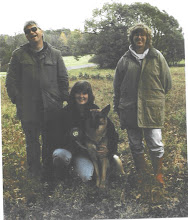I laid a track that went through the field, across the parking lot (rough pavement), and back into the field with a turn in the middle of the parking lot and six turns in the field, some before, some after the parking lot. I love trying to think up a track that's going to be both educational and fun; it's like working on a puzzle but way more exciting.
Milo zipped through the tall grass, checked his work at the first corner by sniffing in each direction, then charged down the next leg. It's so cool to see him disappearing into the tall grass with just his wagging tail in sight.
On the second corner I tried to trick him when I laid the track by walking past the corner about 15 feet, then backing up and making the turn. No problem. He followed the scent to the end, then circled around till he found the next leg. Not only was it not a problem, but it seemed like ordinary business for him. What a dog!
Once Milo paused briefly to look closely at a beautiful, dewy web with a very large Orb Weaver spider hanging in it. Funny thing was, I had paused to look at it (and breathe a sigh of relief that I hadn't run into it) when I laid the track past it. Did he pause because I had and my scent was pooled there? Or did he pause because he saw the spider? I often wonder what goes on in that busy Beagle brain.
Two articles were the ordinary glove or leather piece, one was new and different-- a tube of hand lotion. Milo wasn't expecting that, and he went right past the hand lotion, so I stopped him, showed it to him, then treated him on it as I do with our regular articles. I'll be interested in seeing if he "gets it" next time I use something new.
The transition to pavement was no problem at all. Milo paused briefly, then pulled carefully but confidently along the track, even managing the turn in the parking lot with no difficulty. So much fun!!!! Tracking really is addictive, and all the more so when I can see progress from week to week.
I can hardly wait for tomorrow. I'm not sure where I'll be tracking, but I know I'll work with different articles and probably with different surfaces. Wherever we go and whatever we focus on, it's always such a special time of connecting with my dog in his area of expertise. I've always loved being a student, and it's fascinating being a student of my dog.







